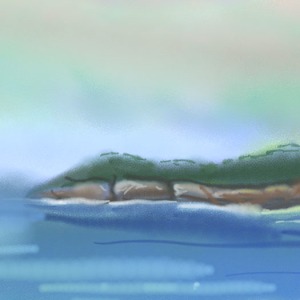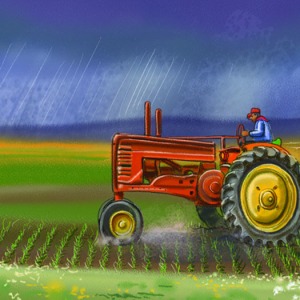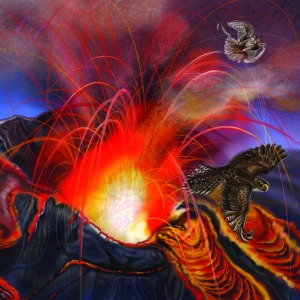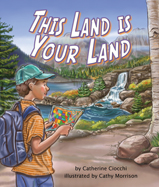Within a year, we have been able to see our solar system as never before. In November 2014, the Philae Probe of the Rosetta spacecraft landed on the halter-shaped Comet 67P/Churyumov-Gerasimenko. In April 2015, the Dawn spacecraft entered orbit around the largest of the asteroids, Ceres (590 miles in diameter), orbiting between Mars and Jupiter. And in July, the New Horizons mission made the first flyby of the dwarf planet Pluto, making it the most distant solar-system object to be visited. Other spacecraft continue to investigate other planets.
The post What makes Earth ‘just right’ for life? appeared first on OUPblog.
Are you looking for a fun family trip this summer? Don’t want to travel too far from home? This Land Is Your Land talks about many different landforms all over the United States. Read this book with your children to teach them about the diverse landscapes of our beautiful country, then pack up the car and head to the nearest (or farthest!) destination. Who says education has to stop in the summer?
 Coastlines: Perhaps the easiest landform to reach for many, the United States coastline is over 95,000 miles long. Many people live on the coast – about 39% of the country’s population! The coast is a very popular tourist destination, and there are hundreds of beaches for people to travel to. Some of the best family beaches are located in the Outer Banks in North Carolina; Maui, Hawaii; Myrtle Beach, South Carolina; Destin, Florida; San Diego, California; and Ocean City, Maryland. There are beaches in every coastal state, though. Which beach is closest to you?
Coastlines: Perhaps the easiest landform to reach for many, the United States coastline is over 95,000 miles long. Many people live on the coast – about 39% of the country’s population! The coast is a very popular tourist destination, and there are hundreds of beaches for people to travel to. Some of the best family beaches are located in the Outer Banks in North Carolina; Maui, Hawaii; Myrtle Beach, South Carolina; Destin, Florida; San Diego, California; and Ocean City, Maryland. There are beaches in every coastal state, though. Which beach is closest to you?
Mountains and hills: Mountains are also another popular place for tourists, especially those who enjoy activities such as hiking and  camping. Some states have more to offer than others when it comes to mountains. For example, the highest point in Florida is only 345 feet above sea level, whereas Alaska’s Mt. McKinley towers 20,320 feet above sea level. However, all 50 states have some sort of forest, lake, or other natural area where camping and nature walks are possible, so even those of you in the flatter states don’t have to miss out!
camping. Some states have more to offer than others when it comes to mountains. For example, the highest point in Florida is only 345 feet above sea level, whereas Alaska’s Mt. McKinley towers 20,320 feet above sea level. However, all 50 states have some sort of forest, lake, or other natural area where camping and nature walks are possible, so even those of you in the flatter states don’t have to miss out!
Plateaus and canyons: In the United States, plateaus are found mainly in the western states, where the Colorado Plateau is. Plateaus provide opportunities for hiking and climbing, and the Colorado Plateau contains the famous Colorado River and Grand Canyon. Many national parks are also in this area, including Zion and Mesa Verde, where you can find smaller plateaus and canyons.
Valleys: A valley is simply a place between mountains or hills, so even states such as Kansas, with very few hills, have some areas that lie lower than others. Beautiful valleys in the United States include the Sedona Verde Valley in Arizona, Napa Valley in California, the Waipi’o Valley in Hawaii, and the Shenandoah Valley in Virginia.
 Plains: The plain region of the United States is called the Great Plains, which runs from Texas north to Oklahoma, Kansas, Nebraska, the Dakotas, and eastern Montana. The Great Plains are known for their extensive flat lands covered in tall grass, cattle ranches, and bison. Be careful here in the spring and summer – the Great Plains are located in Tornado Alley, where tornadoes happen most frequently!
Plains: The plain region of the United States is called the Great Plains, which runs from Texas north to Oklahoma, Kansas, Nebraska, the Dakotas, and eastern Montana. The Great Plains are known for their extensive flat lands covered in tall grass, cattle ranches, and bison. Be careful here in the spring and summer – the Great Plains are located in Tornado Alley, where tornadoes happen most frequently!
Peninsulas: Arbordale Publishing is located near a well-known peninsula –Charleston, South Carolina! Many of the first towns settled in the United States are located on peninsulas, as they provide easy access by water to ships delivering people and supplies. Jamestown, Virginia and Boston, Massachusetts were first built on peninsulas. The entire state of Florida is a big peninsula!
Volcanoes: The west coast of the United States is located in what is  known as the “Ring of Fire,” an area where many volcanic eruptions and earthquakes occur due to the movement of the Earth’s tectonic plates. Active, potentially dangerous volcanoes in the United States include Kilauea Volcano in Hawaii, Mount St. Helens in Washington, Mount Hood in Oregon, Mount Shasta in California. While some of these volcanoes haven’t erupted in years, they are not considered dormant, meaning they could erupt at any time. A volcanic eruption would be an exciting sight to see, but be sure to keep your distance!
known as the “Ring of Fire,” an area where many volcanic eruptions and earthquakes occur due to the movement of the Earth’s tectonic plates. Active, potentially dangerous volcanoes in the United States include Kilauea Volcano in Hawaii, Mount St. Helens in Washington, Mount Hood in Oregon, Mount Shasta in California. While some of these volcanoes haven’t erupted in years, they are not considered dormant, meaning they could erupt at any time. A volcanic eruption would be an exciting sight to see, but be sure to keep your distance!
Islands and archipelagos: The most famous example of an island chain in the United States is Hawaii. Another is the Aleutian Islands in  Alaska. Since neither of these are especially accessible to the average Mackinac, Michigan; Whidbey Island, Washington; Mount Desert, Maine; Amelia Island, Florida; and Assateague Island, Virginia. Did you know that part of the biggest city in the United States is located on an island? Manhattan is surrounded by the Hudson River, the East River, and the Harlem River!
Alaska. Since neither of these are especially accessible to the average Mackinac, Michigan; Whidbey Island, Washington; Mount Desert, Maine; Amelia Island, Florida; and Assateague Island, Virginia. Did you know that part of the biggest city in the United States is located on an island? Manhattan is surrounded by the Hudson River, the East River, and the Harlem River!
Learn more about these landforms in Catherine Ciocchi’s book This Land is Your Land!



If you like your prophecies pin sharp then look away now. The 16th century celebrity seer Nostradamus excelled at the exact opposite, couching his predictions in terms so vague as to be largely meaningless. This has not, however, prevented his soothsayings attracting enormous and unending interest, and his book – Les Propheties – has rarely been out of print since it was first published 460 years ago. Uniquely, for a renaissance augur, the writings of Nostradamus are perhaps as popular today as they were four and a half centuries ago.
The post Look away now: The prophecies of Nostradamus appeared first on OUPblog.
In teaching earth science topics I often found kids to be confused about constructive and destructive forces. Destructive forces wear away the surface of the Earth, while constructive forces help to build it up. It's very hard for kids to understand that an event like a volcanic eruption can be a constructive force, creating new islands (Galapagos, Hawaii, Iceland) and land masses.
Today's book trio looks at the positive impact of volcanic activity.
Poetry Books An Island Grows
An Island Grows, written by Lola M. Schaefer and illustrated by Cathie Felstead, is book-length poem that describes how a volcanic island is formed It begins this way.
Deep, deep
beneath the sea . . .
Stone breaks.
Water quakes.
Magma glows.
Volcano blows.
Lava flows
and flows
and flows.
Poem ©Lola Schaefer. All rights reserved.
The rhyming text continues to describe how the lava builds up unit it breaks through the water's surface. Eventually seeds, plants, and animals, come to the newly formed island. Later, sailors and traders came, settlers stayed, and soon there exists a "Busy island in the sea, where only water used to be." The book concludes by coming full circle and discussing how the cycle starts from the beginning, where “Another island grows.” The last page of the book describes a bit more of the science of island formation.
Volcano! Wakes Up, written by Lisa Westberg Peters and illustrated by Steve Jenkins, is a collection of poems that describe a day in the life of an imaginary Hawaiian volcano. Ferns, lava flow crickets, a small black road, and the volcano itself all speak in these poems. Here's how it opens.
Volcano
I'm the baby.
I'm much smaller than my
big sister volcanoes. I'm a little sleepy
now, but when I wake up, watch out! I throw
nasty tantrums. It always works--I get the most attention!
Here's what the ferns have to say when they realize the volcano is awake.
Ferns
Fire-maker's awake!
She's about to
make
this caldera
a lake of fire and
lava. Ah, the
party
must be over.
Put away all the
streamers.
Say
good-bye,
honeycreepers.
But wait . . . it's
not
hot yet. It's
not even warm
yet. What a
lucky
delay on this
beautiful day. Hey,
everybody, let's
party!
Poems ©Lisa Westberg Paters. All rights reserved.
The back matter of the book describes Hawaiian volcanoes, ferns, lava flow crickets, the road and trail signs that direct visitors to Hawaii Volcanoes National Park, and the best time to watch hot lava enter the ocean.
Nonfiction Picture Book
Volcano Rising, written by Elizabeth Rusch and illustrated by Susan Swan, looks at volcanoes as constructive forces of nature, building up the surface of the Earth. Beautifully illustrated in mixed media with lots of examples and labels, this book uses two levels of text to engage readers. The first level of text provides readers with basic volcano information. This is accompanied by detailed informational text that provides more comprehensive information on volcanoes. Both levels of text are well-written and make the concepts accessible for readers across a range of ages. Together the text and illustrations offer a dramatic introduction to volcanic activity.
Here's a brief excerpt.
Pow! Gases blast lava out in an
explosive eruption.
HISSSSS! Gases and lava slowly seep out
in a creative eruption.
Gas determines whether an eruption creates or destroys.
Rising gas pushes lava out of a volcano. In destructive
eruptions, gases get trapped inside thick magma or are
blocked by plugs in the vents. Pressure builds until lava, ash,
and gases explode all at once, like soda from a shaken can.
Text © Elizabeth Rusch. All rights reserved.Rusch introduces readers to 8 different volcanoes around the world and explores their impact when found in what some might consider unusual places, like under a glacier or on the seafloor. Back matter includes a glossary of 30 volcano vocabulary words and an extensive bibliography.
Perfect Together
Here in Virginia volcanoes are studied in 5th grade. While the poetry books may seem too simple for this age, I wouldn't hesitate to use any of these titles with older students. You might consider reading the mask poems in VOLCANO WAKES UP! and using the glossary and informational text in Rusch's book to help students better understand the vocabulary. Regardless of how you use them, all three provide terrific introductions to volcanoes as constructive forces.
For additional resources, consider these sites.
Could we be leaving our children not only a far hotter world, but a more geologically unstable one too?
In Waking the Giant, Bill McGuire argues that now that human activities are driving climate change as rapidly as anything seen in post-glacial times, the sleeping giant beneath our feet is stirring once again. The close of the last Ice Age saw not only a huge temperature hike but also the Earth’s crust bouncing and bending in response to the melting of the great ice sheets and the filling of the ocean basins — dramatic geophysical events that triggered earthquakes, spawned tsunamis, and provoked a series of eruptions from the world’s volcanoes.
Click here to view the embedded video.
Bill McGuire is Professor of Geophysical and Climate Hazards at University College London. His books include Waking the Giant: How a changing climate triggers earthquakes, tsunamis, and volcanoes, Surviving Armageddon: Solutions for a Threatened Planet, and Seven Years to Save the Planet.
Subscribe to the OUPblog via email or RSS.
Subscribe to only environmental and life sciences articles on the OUPblog via email or RSS.
View more about this book on the 


 In my mini series reviewing the books shortlisted for the Royal Society Young People’s Book Prize 2011 next up is How The World Works by Christiane Dorion and Beverley Young
In my mini series reviewing the books shortlisted for the Royal Society Young People’s Book Prize 2011 next up is How The World Works by Christiane Dorion and Beverley Young
A pop-up book covering a wealth of ground, How The World Works is a tremendous introduction to topics as diverse as the solar system, evolution, plate tectonics, the water cycle, weather systems, photosynthesis and food chains.
Each double page spread covers one theme and explores it using exciting illustrations, illuminating paper engineering and and array of both key and intriguing facts presented in inviting, bite-sized portions. The illustrations have the rich colours and boldness you often see with Barefoot Books (though this is actually published by Templar). The short sections of text make this an undaunting book for young independent readers.

As well of plenty of flaps and tabs, there are lots of instances where the paper engineering really adds to your understanding of the topic under discussion. For example the big bang explosion is a brilliantly executed bit of fold out paper – simple, but very effective as it mimics an explosion. How the continents have drifted over time is beautifully illustrated with a flip book – by flipping the pages we can actually see the continents drifting from the supercontinent Pangaea about 200 million years ago to their current location.
Again, the paper engineering is put to exceptional use to illustrate what happens at different types of plate boundary; Andy Mansfield, the brains behind the pop-up aspect of this book, has created paper tricks that are not only great fun but, but informative and meaningful.

This book contains a subtle but consistent message about how we as humans are having an impact on the earth and what the consequences of our actions will be. In the section on carbon there are tips about how we can reduce our carbon footprint, whilst the pages devoted to how plants work draw attention to the problems caused by deforestation. In the discussion of ocean currents and tides we’re introduced to the Great Pacific Garbage Patch, “an area of plastic rubbish twice the size of Texas” floating in the Pacific ocean, whilst when exploring the the planets, the large quantity of space junk orbiting the earth is highlighted. Not only does this book tell us how the world works, it also makes us think about how it’s beginning to break down.
By Michael Welland
It was a double-dose of adrenalin: watching a violently growing volcanic eruption while retaining a firm grip on my twelve-year old daughter to prevent her sliding off the rolling boat and plummeting into the turbulent waters of the Sunda Strait. The boat was a rickety old tub, the Sumatran helmsman grinning cheerfully. The volcano was Anak Krakatoa.


Volcano Wakes Up! by Lisa Westberg Peters, illustrated by Steve Jenkins
This book of poems follows a day on a an imaginary Hawaiian volcano. All of the creatures on the volcano know that something is about to happen, from the lava flow crickets to the ferns. Even the sun and the volcano itself have poems from their perspective. Young readers will enjoy the tension as it mounts towards the eruption and then the drama and intensity of the eruption itself.
This is Peter’s second book of poetry about geology. Peter’s poetry ranges through a variety of different styles in the book. Each different voice has its own poetic form. The volcano’s verse is shaped like a mountain. The have a curling but upright form. There are poems told in road signs and then the crickets speak in texts. It is a very clever device that will have children eager to move to the next poem because of the interesting and changing nature of the verse itself.
Jenkins’ illustrations are as gorgeous as always. Done in cut-paper collage, they perfectly capture the changing nature of the day. Some illustrations are crisp and clear, with detailed crickets and ferns. Others are landscapes with mists and mountains that are soft and evocative. Simply lovely.
A perfect marriage of science, poetry and art, this book will be adored by volcano fans and poetry fans alike. Appropriate for ages 6-9.
Reviewed from copy received from Henry Holt.

iTunes users can subscribe to this podcast 
 The volcano that spewed ash into the Icelandic skies and disrupted world air travel has a name that’s pretty difficult to pronounce and pretty difficult to spell; it’s Eyjafjallajökull. This evidently means “island mountain glacier.” Nothing about volcanoes, fire or ash in that word.
The volcano that spewed ash into the Icelandic skies and disrupted world air travel has a name that’s pretty difficult to pronounce and pretty difficult to spell; it’s Eyjafjallajökull. This evidently means “island mountain glacier.” Nothing about volcanoes, fire or ash in that word.
The volcano that was first called a volcano, however, does have a name relating to its fiery fame. Mount Etna is on the island of Sicily which is the island that the boot of Italy is kicking. The name Etna is thought—according to Adrian Room’s book Placenames of the World—to have originated from a Phoenician word attuna meaning “furnace.” He dismisses the theory that Etna is from a Greek source meaning “I burn.”
Mount Etna holds a place in Roman mythology as the furnace of the god of fire and blacksmithing. That god’s name was Vulcan hence the word volcano which appeared as an English word in 1613 in the travel writings of Samuel Purchas. So from that day to this travel and volcanoes seem to be strangely linked.
Five days a week Charles Hodgson produces
Podictionary – the podcast for word lovers, Thursday episodes here at OUPblog. He’s also the author of several books including his latest
History of Wine Words – An Intoxicating Dictionary of Etymology from the Vineyard, Glass, and Bottle.

















 4 Comments on How the world works…, last added: 11/23/2011
4 Comments on How the world works…, last added: 11/23/2011


Can see why this book is shortlisted. It looks totally fabulous. – It has a bits and pieces of everything in it!!! Wonderful projects – and you know how we love projects!!! Great review, so much to look at!!!
Thanks Se7en, I definitely think this is a book your family would enjoy reading and be inspired by. For me it’s been a case of being so glad I blog about books – it’s one of those books I’m so glad to have for my kids.
That looks like a fantastic book, I love it when there are flaps to find lots of new hidden facts.
I LOVE your flip book too.
x
I can’t recommend this book enough – we really are so pleased to have a copy in our home!
I was really please with how the flip book worked out Emma – the girls really wanted to create one but coming up with one that they could do themselves required some thought as the drawing bit was just a little too frustrating for them. The moon phases worked perfectly.